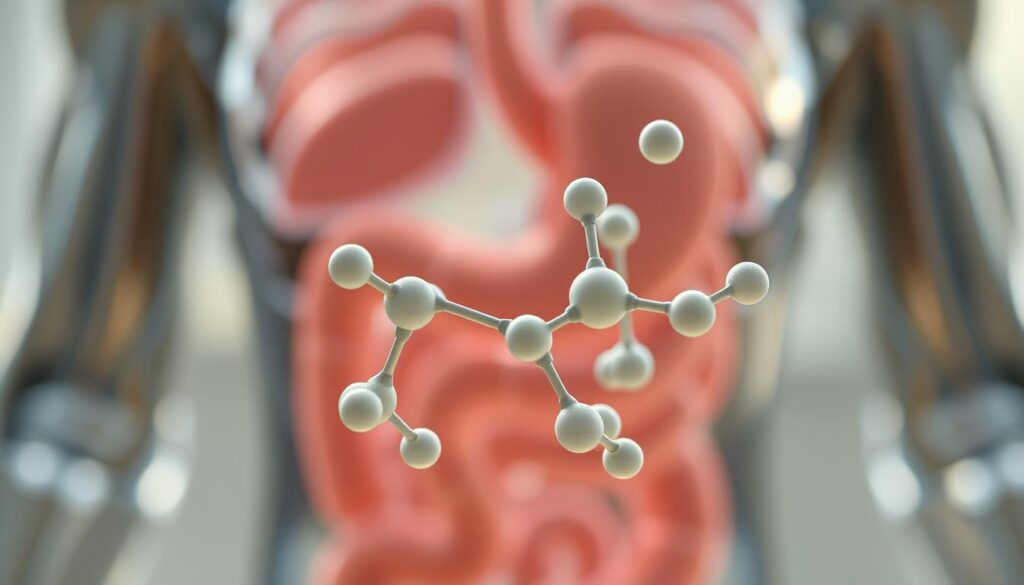
Magnesium Chelate vs Oxide: Which Is Better Post Workout?
Are you looking for the best way to recover after a workout? You might have seen magnesium chelate and magnesium oxide. Knowing the difference can really help your recovery and fitness goals.
This article will give you key info on magnesium. It will help you choose between magnesium chelate and magnesium oxide for your recovery needs.
Understanding Magnesium: An Overview
Magnesium is vital for your health, playing a key role in over 600 biochemical reactions. It’s essential for energy production, nerve function, and muscle contraction. Sadly, nearly two-thirds of people in the Western world don’t get enough magnesium.
There are different types of magnesium, each with its own benefits. Common sources include:
- Green leafy vegetables
- Nuts
- Legumes
Knowing how magnesium works is key to understanding its importance. It supports many bodily systems, helping you feel your best. Getting enough magnesium is important for health and performance during exercise.
Importance of Magnesium for Muscle Recovery
After hard exercise, your body needs enough magnesium for good muscle recovery. This key mineral helps relax muscles by blocking calcium. It reduces muscle soreness and cramps, helping you recover faster.
Magnesium also helps activate vitamin D, which is vital for muscle health. Having enough magnesium means you can recover quicker and perform better in future workouts.
Eating foods rich in magnesium or taking supplements can help you recover faster. Foods like leafy greens, nuts, seeds, and whole grains are good sources. A diet rich in magnesium supports muscle recovery and boosts your overall health and fitness.
Magnesium Chelate vs Oxide: A Nutritional Comparison
Choosing a magnesium supplement can be tricky. Knowing the difference between magnesium chelate and magnesium oxide helps. Each type has its own role and how well it works depends on how well it’s absorbed. Let’s look at how they compare nutritionally.
What is Magnesium Chelate?
Magnesium chelate is magnesium linked to amino acids. This makes it easier for the body to absorb. It’s a favorite among athletes because it helps with muscle recovery.
It can relax muscles and prevent cramps after exercise. This makes it a great choice for those who are active.
What is Magnesium Oxide?
Magnesium oxide is magnesium mixed with oxygen. It has more magnesium by weight. But, it might not be as easily absorbed as magnesium chelate.
This could mean it’s not as effective for quick muscle recovery. Yet, it’s often cheaper. So, people might take more of it to get the same benefits.
Bioavailability: How Well Does Your Body Absorb Magnesium?
Knowing about magnesium bioavailability is key to picking the right supplements. Different types of magnesium absorb at different rates. This affects how well your body uses these minerals.
Not all supplements are the same. For example, magnesium citrate and magnesium chelate are known for better absorption. On the other hand, magnesium oxide is less effective.
Comparing Absorption Rates
| Form of Magnesium | Bioavailability Rating | Ideal Usage |
|---|---|---|
| Magnesium Citrate | High | General supplementation |
| Magnesium Chelate | High | Post-workout recovery |
| Magnesium Oxide | Low | Dietary support |
Factors Affecting Bioavailability
Several things can change how well you absorb magnesium supplements. These include:
- Supplement Form: Some forms are easier for your body to absorb.
- Dietary Composition: Eating certain foods with magnesium can help or hurt absorption.
- Gut Health: A healthy digestive system is key for nutrient absorption.
- Age and Gender: These can affect how well your body absorbs nutrients.

Benefits of Magnesium Chelate for Post Workout Recovery
Recovering after a workout is key to your fitness journey. Magnesium chelate helps a lot with this. It supports muscle relaxation and reduces muscle cramps, helping you recover faster and stronger.
Support for Muscle Relaxation
Magnesium helps you relax and recover faster. It prevents stiffness and makes recovery smoother. This way, you can get back to your next workout without feeling sore.
Studies show magnesium chelate reduces muscle tension. This makes your post-workout experience more comfortable and enjoyable.
Role in Reducing Muscle Cramps
Muscle cramps can stop your fitness plans. But magnesium chelate might help. It can make cramps less frequent and less intense after exercise.
This is great for intense training or long events. With magnesium, athletes can stay focused on their performance without pain.
Benefits of Magnesium Oxide: When is It Useful?
Magnesium oxide is important in nutrition and supplements. It’s not mainly for muscle recovery. But, it has magnesium oxide benefits for digestive health. It helps with discomfort after exercise.
Digestive Health Support
Many face digestive problems, often after hard workouts. Adding magnesium can help with digestive health. Here are key points about magnesium for digestion:
- Helps alleviate symptoms of heartburn by relaxing the esophagus.
- Reduces chances of constipation by promoting bowel movements.
- Supports the digestion of food, which can enhance nutrient absorption.
- Contributes to better gut health, which is key for overall wellness.
Magnesium oxide’s role in digestive health is vital. It’s important for those who exercise a lot. Good gut health improves recovery and performance.
| Benefit | Description |
|---|---|
| Heartburn Relief | Magnesium oxide can relax the esophagus, helping to minimize discomfort. |
| Constipation Aid | This mineral assists in promoting regular bowel movements. |
| Nutrient Absorption | By supporting digestion, magnesium improves the absorption of essential nutrients. |
| Gut Health | Maintaining digestive balance enhances overall well-being. |
Potential Side Effects of Magnesium Supplements
Magnesium supplements can be very helpful, but it’s important to know the possible side effects. Knowing about magnesium oxide side effects and other issues helps you make smart choices. Being aware of the risks ensures you stay safe and healthy.
Common Risks Associated with Magnesium Oxide
Magnesium oxide is commonly used but has its downsides. Some common side effects include:
- Digestive issues such as diarrhea
- Nausea or vomiting, often in high doses
- Abdominal discomfort or cramping
These issues can be a problem, mainly for those who easily get upset stomachs. It’s key to watch how your body reacts when starting a new supplement.
Side Effects of Magnesium Chelate
Magnesium chelate is seen as having fewer side effects. Yet, it’s not without risks. Possible side effects include:
- Mild digestive upset in some cases
- Interactions with certain medications, affecting how well they work
- Fatigue or dizziness if taken too much
Knowing the risks of magnesium supplements helps you choose the right amount and type for you. Always talk to a healthcare professional to ensure your supplements are safe and effective.
How to Choose the Right Magnesium Supplement for Your Needs
Choosing the right magnesium supplement is important. You need to think about your health and fitness goals. First, check if you’re getting enough magnesium from food like leafy greens and nuts. If you are, you might only need a supplement for specific needs.
Look at how well the supplement is absorbed by your body. Magnesium chelate is better absorbed than magnesium oxide. It’s great for recovery after workouts. If you’re worried about muscle relaxation and cramps, choose magnesium chelate.
But, if you’re focusing on your digestive health, magnesium oxide might be better. It has a lower absorption rate but can help with digestion.
Remember to follow the recommended dosages. Starting with a small dose and increasing as needed is best. This way, you can choose magnesium supplements that help your fitness and health.



